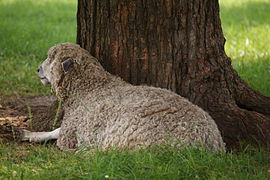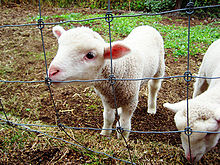- English Leicester (sheep)
-
 a Leicester Longwool at Colonial Williamsburg
a Leicester Longwool at Colonial Williamsburg
English Leicester are an English breed of sheep. Alternate names for the breed include: Leicester, Bakewell Leicester, Dishley Leicester, Improved Leicester, Leicester Longwool, and New Leicester. They were originally developed by 18th century breeding innovator Robert Bakewell.[1]
It is now one of Britain's rarest breeds, categorised as "endangered" by the Rare Breeds Survival Trust since there are fewer than 500 registered breeding females in the United Kingdom.[2]
Contents
History
English Leicester sheep date back to the 1700s and were found in the Midland Counties of England. It was developed by a man called Robert Bakewell who was the foremost exponent of modern animal breeding techniques in the selection of livestock. The English Leicester back in the 1700s was slow growing and coarsely boned. These days the animals have been developed to gain weight quickly and are fast growing. English Leicester was one of the first pure sheep breeds introduced to Australia being introduced in 1826. The English Leicester has been used to improve many sheep breeds because of its meaty carcase and heavy fleece. It is one of the few breeds that are truly pure.
Appearance
- The head of an English Leicester should be carried well, no too high and should have no signs of horns on the poll (forehead). The face is generally in a wedge shape, covered in white hairs and can appear to have a blue tinge. The lips and nostrils should be black. Having black specks on the face and ears is not objectionable.
The neck of a Leicester should be of medium length. The shoulders should be strong and level with the back which should be flat.
- Their legs should be straight and wide apart and their hooves should be black.
- The English Leicester should be free, active and well balanced whilst in movement.
- The Fleece should be dense (having thick and blocky clumps of wool also known as the staple). It should be lustrous indicating the shine on the wool and should have a well-defined crimp or wave from skin to tip.
The common fibre diameter for an English Leicester is 32 to 38 micrometres (microns). The English Leicester should appear to be alert and robust, showing style and character.
Other information
The English Leicester is currently found in Australia, New Zealand, Great Britain and the US. They are a sound footed sheep which means they are acceptable on flat, hilly or more especially marginal country. They are large framed sheep with a wide even topline (back) a strong constitution and a good temperament.
References
- ^ "Leicester Longwool". Breeds of Livestock. Oklahoma State University, Dept. of Animal Science. http://www.ansi.okstate.edu/breeds/sheep/leicesterlongwool/index.htm. Retrieved 2010-09-08.
- ^ "Leicester Longwool". Sheep. Rare Breeds Survival Trust watch list. http://www.rbst.org.uk/watch-list/sheep/leicesterlongwool. Retrieved 2008-05-21.
External links
- Leicester Longwool Sheep Breeders Association (UK)
- Leicester Longwool Sheep Breeders Association (USA)
- English Leicester Association of Australia, Inc.
- Australian Stud Sheep Breeders Association (English Leicester section)
- New Zealand Sheep Breeders Association (English Leicester section)
- Animal Genetics Data Bank, Hannover Germany (Leicester Longwool section)
Categories:- Sheep breeds
- Sheep breeds originating in England
Wikimedia Foundation. 2010.

